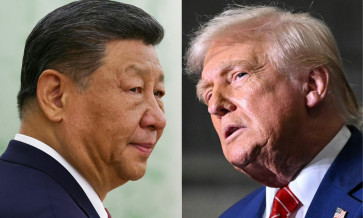Popular Reads
Top Results
Can't find what you're looking for?
View all search resultsPopular Reads
Top Results
Can't find what you're looking for?
View all search resultsAncient hot spring gives clues about lost palace of Majapahit
Hot spring hover: An aerial image reveals the structure of the Sumberbeji hot spring in Jombang, East Java
Change text size
Gift Premium Articles
to Anyone
H
ot spring hover: An aerial image reveals the structure of the Sumberbeji hot spring in Jombang, East Java.(Courtesy of BPCB Trowulan/File)
The recent discovery of an ancient pentirtaan (hot spring) in Sumberbeji village, Jombang regency, East Java, may provide clues to the location of the palace of the short-lived Kahuripan kingdom that later became seat of the strongest female ruler in the history of the Majapahit kingdom, Tribhuwana Tunggadewi.
According to Wicaksono Dwi Nugroho, an archaeologist from the Trowulan Cultural Heritage Preservation Agency (BPCB) in East Java and the head of the Sumberbeji site excavation team, among the archaeological findings that support the assumption were an ancient brick structure about three kilometers north of the hot spring and the Rimbi Temple about 14 kilometers southeast of Sumberbeji.
The excavation of the Sumberbeji site, which is believed to have existed prior to the Majapahit kingdom and was later refurbished during that period, has so far unveiled almost the entire structure of a building and the architectural landscape. The management of the water supply for the hot spring and a water fountain inside the pentirtaan is also considered quite complicated and advanced. The water from the canal was channeled in three directions: to the left and to the right through the hot spring walls and out the front through a meru (mountain symbol) structure that existed in the middle of the pentirtaan. As the result, the water was distributed through dozens of fountains of several different heights.
“The architecture’s sophistication, the water supply and fountain system, the smoothness of the carvings on the garuda statue and dozens of jaladwara [waterway segments] and the discovery of ceramics from the Song and Yuan dynasties indicate this hot spring was built and used by the royal family. The question is: Where’s the palace?” Wicaksono recently told The Jakarta Post.
Previous findings of brick structures in the Sugihwaras and Kedaton hamlets, which are only about 100 meters from each other, supported this assumption as they are believed to be parts of the structure of a palace from the
Majapahit era.
“The gateway in the Sugihwaras site, the thickness of the wall foundation that is about 80 centimeters and the name ‘Kedaton’ itself [which is Javanese for palace], also indicates to us that the two sites were part of a palace complex,” Wicaksono added.
Meanwhile, the Rimbi Temple, which was found by Dutch biologist Alfred Wallace in the late 19th century, is believed by historians to be a temple dedicated to Tribhuwana Tunggadewi, the third ruler of the Majapahit kingdom. In the temple complex, researchers found a statue of Parvati, the Hindu goddess of fertility who was the wife of the Hindu god Shiva. At the temple, Parvati was regarded as a representation of Tribhuwana Tunggadewi.
“This Kahuripan [kingdom] arose in the era of King Airlangga until the time when the Kadiri kingdom was divided into two and later run by Airlangga’s two heirs. The name Kahuripan itself was forgotten during the Singhasari kingdom era but existed again in the Majapahit era with Tribhuwana as Bre Kahuripan [regent of Kahuripan],” said Wicaksono. “However, the exact location of the Kahuripan palace has not been discovered until today.”
Tribhuwana Tunggadewi, also known as Dyah Gitarja, was the daughter of the Majapahit kingdom’s founder and first king, Raden Wijaya. When her stepbrother, Jayanegara, took over the throne, replacing Raden Wijaya, Tribhuwana was given the title Bhre Kahuripan and was allocated the Kahuripan kingdom as her territory with Jiwana as the capital. In ancient manuscripts, Jiwana is the name of a place, the location of which has not yet been confirmed.
After Jayanegara, Tribhuwana took the throne of the Majapahit kingdom in the second quarter of the 14th century. Her reign ran until early in the second half of the century, which is known as the era of Majapahit’s territorial expansion when Gajah Mada was the mahapatih (prime minister). It was during this period that Gajah Mada swore the famous Sumpah Palapa (Palapa Oath), in which he stated that he would not eat palapa fruit — meaning he would not rest — until all the kingdoms across the archipelago were united.
Tribhuwana Tunggadewi later passed the throne on to her son, Hayam Wuruk around the year 1351 and she returned to Jiwana as Bhre Kahuripan. The era of Hayam Wuruk and mahapatih Gajah Mada is known as the golden era of Majapahit. However, some historians state that its glory was highly influenced by Tribhuwana.
Titi Surti Nastiti, an archaeologist from National Archaeology Research Center who has conducted special research on ancient cultural heritage items and sites in Jombang regency, questioned the basis of the hypothesis that the area around the Sumberbeji site until Sugihwaras was the location of Kahuripan city.
Titi said that plenty of archaeological sites with artifacts were found from the southwest of Jombang to Pare in Kediri, but it was still too early to conclude that they were connected with one another.
Archaeologist Transpiosa Riomandha, who founded a Facebook group named Bolbrutu comprising national archaeology and history observers, called the aforementioned theory interesting because tracing the location of an ancient palace or capital is usually based on old prasasti (inscriptions).
“However, the hypothesis makes sense if we consider the position among other sites around the area,” Transpiosa added.










